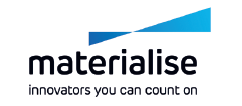Congenital disorders
Introduction
This page provides an overview of some congenital conditions that affect the face. Congenital disorders are conditions that are already present at birth. The diagnosis can sometimes be made before birth, but often genetic analysis is needed after birth to confirm the exact diagnosis. Treatment requires a multidisciplinary approach and is preferably done in reference centres.
Cleft Lip and Palate
- Definition: A cleft lip is a cleft in the upper lip and a cleft palate is a cleft in the palate. They can occur separately or together.
- Causes: Genetics, environmental factors and a combination of both can cause these conditions. Some medications or health problems during pregnancy can also increase the risk.
- Treatment:
- Prenatal counselling at a referral centre with a member of the multidisciplinary team
- Surgery: Several surgeries are usually needed, performed in the first few months or years of life.
- Speech therapy: Helps with speech and feeding problems.
- Dental care: Orthodontic treatments may be needed.
Craniosynostosis
- Definition: Early closure of a baby's cranial sutures, causing an abnormal shape of the head. Depending on which cranial suture closes too early, there are different shape abnormalities of the head.
- Causes: Usually unknown, but may be genetic or part of a syndromic picture.
- Symptoms: Abnormal shape of the head. With several prematurely closed skull sutures, a forehead pressure on the brain may occur. This requires more urgent treatment given the risk of developmental delay.
- Treatment:
- Treatment requires a multidisciplinary approach and is preferably done in reflex centres, where a specialised neurosurgeon and MKA doctor are present.
- The timing of surgery depends on type of surgery chosen.
- Purpose of surgery : Restoring normal head shape and reopening the prematurely closed skull suture.
- Type of surgery :
- Minimally invasive surgery : In this, only the prematurely closed skull suture is removed through a small incision. Through helmet therapy, the head regains its normal shape after surgery. This procedure is not possible for every type of abnormal head shape.
- Remodelling surgery : The abnormal parts of the skull are surgically reshaped. The patient stays slightly longer in hospital and the scar runs from ear to ear in the hairline.
Syndromes with Facial Deformity
Several genetic syndromes can cause facial deformities. Some are:
- Treacher Collins Syndrome: Underdeveloped cheekbone, upper, lower jaw and chin with often incompletely shaped ears.
- Apert syndrome: Due to premature closure of some cranial sutures, there is an abnormal head shape accompanied by an underdeveloped midface.
- Pierre Robin sequence: Due to the small lower jaw, the tongue tends to fall backwards, causing breathing difficulties. There is also a cleft palate.
- Causes: After genetic screening, a causative gene can be pinpointed.
- Treatment: Treatment requires a multidisciplinary approach and is preferably carried out in referral centres. Each syndrome has a specific approach, which consists of a combination of surgery, orthodontics and speech therapy.
Coping and Support
- Genetic counselling: Provides information and guidance for families with a history of these disorders.
- Support groups: Brings families going through similar experiences together for mutual support.
- Therapy: Psychological support for both the child and the family can be helpful.
Key takeaways
- Most congenital facial defects can be treated with surgery and therapy. Treatment requires a multidisciplinary approach and is preferably done in centres of reference.
- Early diagnosis and intervention lead to the best results.
- Support is available for families facing these challenges.
For More Information
Speak to your healthcare provider or genetic counselor about any concerns or questions you may have. They can offer guidance, resources, and further information tailored to your needs.
Note: This page provides general information only. Consult with a healthcare professional for specifics related to individual needs.














